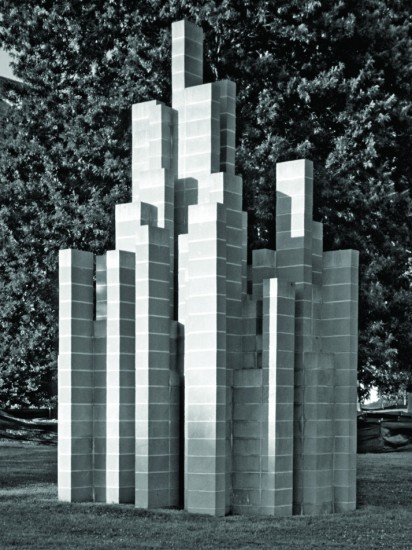 Sol LeWitt (1928-2007) was an American Conceptualist and Minimalist painter and sculptor from nearby Hartford, Connecticut.
Sol LeWitt (1928-2007) was an American Conceptualist and Minimalist painter and sculptor from nearby Hartford, Connecticut.
In the early 1950s, LeWitt attended the School of Visual Arts and pursued side work as a graphic designer for the architect I.M. Pei and Seventeen magazine. In 1960, he took a job at the Museum of Modern Art in New York City as a receptionist and clerk, surrounding himself with works by Mark Rothko, Le Corbusier, and Edward Steichen. These influences allowed LeWitt to develop his artistic style, which is geometric, saturated with color, and systematically formulated.
In addition to drawing and painting, LeWitt began exploring three-dimensional work. His first sculptures, or as he liked to call them, ‘structures’, were primarily wooden, closed forms. In the mid 1960s, LeWitt decided to take a drastically new approach to his three-dimensional work by revealing the structure of forms, and the square became an iconic shape for his ‘building block’ fascination. This shift led LeWitt to experiment with stacked cinder blocks as a way to create monumental ‘structures’, and much of his work from the late 1980’s and early 1990’s reflects this trend. In 1997, LeWitt created Irregular Tower (Horizontal Bricks #2), which was installed at Connecticut College just south of Freeman House during the same year.
According to the Sculpture and Decorative Arts Conservation Services LLC report in 2009, the piece is listed with moderately high conservation priority. yet its current condition is listed as ‘poor’. On the surface, the sculpture has several orange and black stains due to moisture accumulation, salt deposits and lichen growth. Chunks from lower part of the piece are missing, most likely a result of weed-whacking or mowing damage.
The Sculpture and Decorative Arts Conservation Services LLC report recommends a “wash once per year with a nonionic detergent. When mowing, keep at least one foot away from the sculpture.” In fact, the report divulged, “the artist’s intent should be clarified in order to determine whether or not weathering, staining, and biogrowth were desired and appropriate. After getting in touch with LeWitt’s assistant, Susanna Singer, she expressed that “Mr. LeWitt would not have wanted the object to become stained or covered with bioflora. He preferred clean lines and was not interested in having the piece revert to nature.” •









